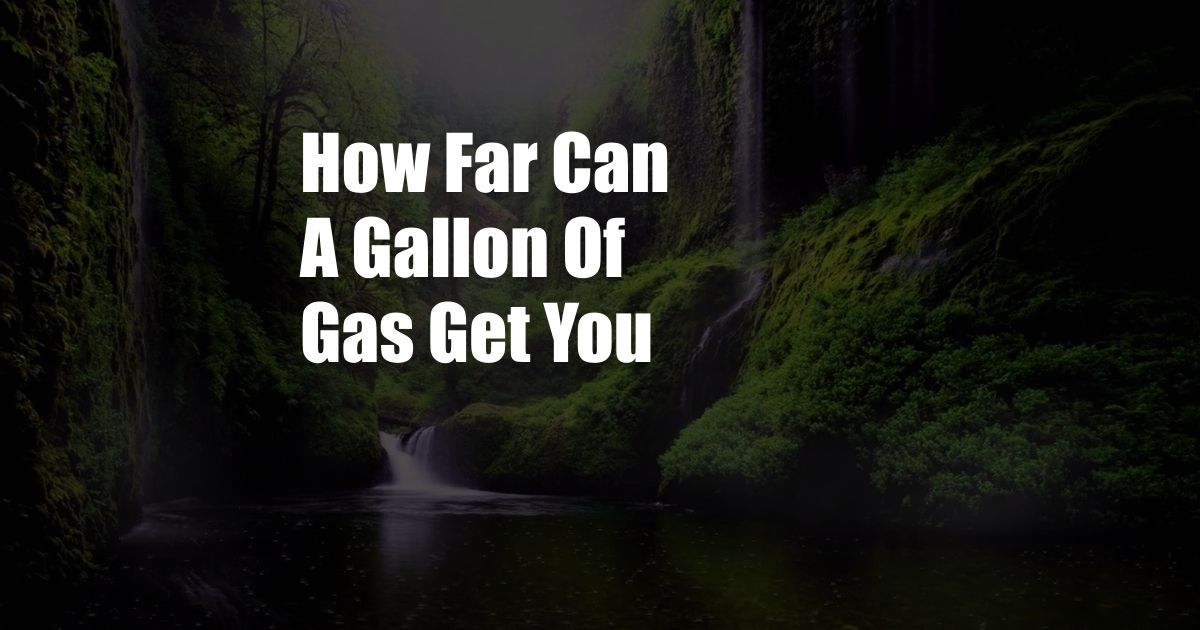
How Far Can a Gallon of Gas Get You?
A few months back, I filled up my car’s gas tank and embarked on a road trip across the beautiful state of Oregon. I had a full tank of gas and an optimistic spirit. As I drove along the scenic highways, I started wondering, “How far can a gallon of gas get me?”
Fuel Economy and Vehicle Performance
Fuel economy, measured in miles per gallon (MPG), determines how far a vehicle can travel on a single gallon of fuel. Several factors influence a car’s fuel economy, including engine size, vehicle weight, and driving conditions. Generally, smaller and lighter vehicles with smaller engines have better fuel economy than larger and heavier vehicles with larger engines.
Driving Techniques for Improved Fuel Efficiency
Besides vehicle factors, your driving habits significantly impact fuel consumption. To improve fuel efficiency, practice these techniques:
- Maintain steady speeds: Avoid rapid acceleration and deceleration, as they waste fuel. Use cruise control on highways to maintain a constant speed.
- Reduce idling: Turn off your engine when stopped for extended periods, such as at red lights or drive-throughs.
- Combine errands: Plan your trips wisely to minimize unnecessary driving. Combine errands that require you to visit multiple locations.
- Use air conditioning sparingly: Air conditioning consumes fuel, so only use it when necessary. Open windows for ventilation instead.
- Maintain your vehicle: Regularly service your car and check tire pressure. Improperly inflated tires can increase rolling resistance and reduce fuel economy.
Calculating Fuel Consumption and Range
To estimate how far you can travel on a gallon of gas, divide your vehicle’s MPG rating by the gallons of fuel in your tank. For example, if your car has a 20 MPG rating and a 15-gallon tank, you can expect to travel approximately 300 miles (20 MPG x 15 gallons = 300 miles).
Factors Affecting Fuel Efficiency
Numerous factors can affect your vehicle’s fuel efficiency, including:
- Road conditions: Driving in hilly or mountainous areas requires more fuel than driving on flat roads.
- Traffic congestion: Idling in traffic wastes fuel.
- Weather conditions: Cold weather and windy conditions can reduce fuel economy.
- Load: Carrying heavy loads in your vehicle increases fuel consumption.
Latest Trends in Fuel Efficiency
Automakers are continuously developing innovations to enhance fuel efficiency, including hybrid and electric vehicles, lightweight materials, and advanced engine technologies. Electric vehicles have zero emissions and offer exceptional fuel efficiency, making them an increasingly popular choice.
Frequently Asked Questions (FAQs)
Q: What is the average MPG for a car?
A: The average MPG for cars in the United States is around 25 MPG.
Q: Which factors affect fuel economy the most?
A: Vehicle size, engine size, driving habits, and road conditions significantly influence fuel economy.
Q: How often should I get my car serviced?
A: Regular maintenance, such as oil changes and tire rotations, helps maintain optimal fuel efficiency. Consult your vehicle’s manufacturer guidelines for specific maintenance intervals.
Conclusion
Understanding how far a gallon of gas can get you empowers you to make informed choices that optimize fuel consumption and save you money. By following the tips and techniques discussed in this article, you can improve your vehicle’s fuel efficiency and reduce your environmental impact.
Are you interested in learning more about fuel efficiency and sustainable transportation? Join our online forum or follow us on social media for the latest updates and expert advice.